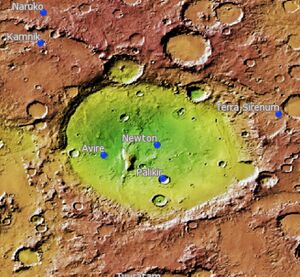Newton (Martian crater)
Topic: Astronomy
 From HandWiki - Reading time: 7 min
From HandWiki - Reading time: 7 min
 Topographic map of Newton crater | |
| Planet | Mars |
|---|---|
| Coordinates | [ ⚑ ] : 40°48′S 201°54′E / 40.8°S 201.9°E |
| Diameter | 298 km |
Newton is a large crater on Mars, with a diameter close to 300 km. It is located south of the planet's equator in the heavily cratered highlands of Terra Sirenum in the Phaethontis quadrangle. The crater was named in 1973 by the International Astronomical Union (IAU) Working Group for Planetary System Nomenclature (WGPSN) in honor of British physicist Sir Isaac Newton.[1]
Three smaller craters within Newton have been named. Avire is to the west of the central peak. Palikir and Dechu are to the southeast of the central peak.
Description
The impact that formed Newton likely occurred more than 3 billion years ago. The crater contains smaller craters within its basin and is particularly notable for gully formations that are presumed to be indicative of past liquid water flows. Many small channels exist in this area; they are further evidence of liquid water. On the basis of their form, aspects, positions, and location amongst and apparent interaction with features thought to be rich in water ice, many researchers believed that the processes carving the gullies involve liquid water. However, this remains a topic of active research. As soon as gullies were discovered,[2] researchers began to image many gullies over and over, looking for possible changes. By 2006, some changes were found.[3] Later, with further analysis it was determined that the changes could have occurred by dry granular flows rather than being driven by flowing water.[4][5][6] With continued observations many more changes were found in Gasa Crater and others.[7] With more repeated observations, more and more changes have been found; since the changes occur in the winter and spring, experts are tending to believe that gullies were formed from dry ice. Before-and-after images demonstrated the timing of this activity coincided with seasonal carbon-dioxide frost and temperatures that would not have allowed for liquid water. When dry ice frost changes to a gas, it may lubricate dry material to flow especially on steep slopes.[8][9][10] In some years frost, perhaps as thick as 1 meter.

In 2011 it was announced that images captured by NASA's Mars Reconnaissance Orbiter have suggested the presence of possible flowing water during the warmest months on Mars, as shown in images taken of Newton Crater and Horowitz Crater among others.
Channels
There is enormous evidence that water once flowed in river valleys on Mars.[11][12] Images of curved channels have been seen in images from Mars spacecraft dating back to the early seventies with the Mariner 9 orbiter.[13][14][15][16] Indeed, a study published in June 2017, calculated that the volume of water needed to carve all the channels on Mars was even larger than the proposed ocean that the planet may have had. Water was probably recycled many times from the ocean to rainfall around Mars.[17][18] The pictures below show a channels in Newton Crater.
Dunes
Dunes are also dominant in the middle of the large crater.
See also
- Climate of Mars
- Dunes
- HiRISE
- HiWish
- Impact event
- List of craters on Mars
- Martian Gullies
- Ore resources on Mars
- Planetary nomenclature
- Seasonal flows on warm Martian slopes
- Water on Mars
References
- ↑ "Newton". Gazetteer of Planetary Nomenclature. USGS Astrogeology Research Program.
- ↑ Malin, M., Edgett, K. 2000. Evidence for recent groundwater seepage and surface runoff on Mars. Science 288, 2330–2335.
- ↑ Malin, M., K. Edgett, L. Posiolova, S. McColley, E. Dobrea. 2006. Present-day impact cratering rate and contemporary gully activity on Mars. Science 314, 1573_1577.
- ↑ Kolb, et al. 2010. Investigating gully flow emplacement mechanisms using apex slopes. Icarus 2008, 132-142.
- ↑ McEwen, A. et al. 2007. A closer look at water-related geological activity on Mars. Science 317, 1706-1708.
- ↑ Pelletier, J., et al. 2008. Recent bright gully deposits on Mars wet or dry flow? Geology 36, 211-214.
- ↑ NASA/Jet Propulsion Laboratory. "NASA orbiter finds new gully channel on Mars." ScienceDaily. ScienceDaily, 22 March 2014. www.sciencedaily.com/releases/2014/03/140322094409.htm
- ↑ "NASA Spacecraft Observes Further Evidence of Dry Ice Gullies on Mars". http://www.jpl.nasa.gov/news/news.php?release=2014-226.
- ↑ "HiRISE | Activity in Martian Gullies (ESP_032078_1420)". http://hirise.lpl.arizona.edu/ESP_032078_1420.
- ↑ "Gullies on Mars Carved by Dry Ice, Not Water". 16 July 2014. http://www.space.com/26534-mars-gullies-dry-ice.html.
- ↑ Baker, V., et al. 2015. Fluvial geomorphology on Earth-like planetary surfaces: a review. Geomorphology. 245, 149–182.
- ↑ Carr, M. 1996. in Water on Mars. Oxford Univ. Press.
- ↑ Baker, V. 1982. The Channels of Mars. Univ. of Tex. Press, Austin, TX
- ↑ Baker, V., R. Strom, R., V. Gulick, J. Kargel, G. Komatsu, V. Kale. 1991. Ancient oceans, ice sheets and the hydrological cycle on Mars. Nature 352, 589–594.
- ↑ Carr, M. 1979. Formation of Martian flood features by release of water from confined aquifers. J. Geophys. Res. 84, 2995–300.
- ↑ Komar, P. 1979. Comparisons of the hydraulics of water flows in Martian outflow channels with flows of similar scale on Earth. Icarus 37, 156–181.
- ↑ "How Much Water Was Needed to Carve Valleys on Mars? - SpaceRef". http://spaceref.com/mars/how-much-water-was-needed-to-carve-valleys-on-mars.html.
- ↑ Luo, W., et al. 2017. New Martian valley network volume estimate consistent with ancient ocean and warm and wet climate. Nature Communications 8. Article number: 15766 (2017). doi:10.1038/ncomms15766
External links
- Google Mars linked to the Newton Crater
- NASA Astronomy Picture of the Day: Newton Crater: Evidence for Recent Water on Mars (26 June 2000)
- Newton Crater
- Solar Views
 |
 KSF
KSF








